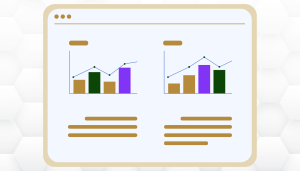
Share
Okay, I’ve got a question, and it’s not the one the title poses. We’ll get to that later, though, so sit tight! The question I’ve got in mind is, how do you measure success? More specifically, how do you measure the performance that leads to and helps determine success?
Back in high school and college, grades were direct reflections of our success, right? Oh, and those little end-of-year awards that we all had to assemble for before wandering off for summer break. But what about now? What avenues can we take to measure our growth and success?
A broad question, I know, but in the world of affiliate marketing? We’ve got KPIs. And, you know, for such a short acronym, those three letters pack quite a punch.
KPIs, or key performance indicators, are measurable metrics that show how well your brand is performing against your objectives and priorities. A few examples of these key performance indicators are revenue, clicks, average order value, and conversion rate. By measuring those, you’ll be able to know how your brand and the affiliates in your program are performing at any time.
Yeah, KPIs are kind of a big deal:
- They measure the success, yearly and monthly progress, and health of your brand
- They can help prove your ROI
- They allow you to identify holes in your strategy, solve problems, and take key opportunities
- They analyze patterns and trends over time
That deserves a wow at the very least. And these are only a handful of reasons why the three-letter acronym is so essential. I have to say, each one paints a pretty clear picture: KPIs are vital in determining both the performance and the success of brands and their affiliate programs.
Now, performance is one thing, but what about overall success? How is that identified?
Hmm… I can’t speak for all of affiliate, but the way we’ve always gone about it is through the steady measurement of KPIs. By keeping tabs on metrics like revenue, clicks, and conversion rates over months, quarters, and years, we can gauge the success of a brand and its affiliates, whether overall or within more specific margins. Success is what you make it, of course, but with KPIs, we can monitor it.
The thing is, keeping track of every KPI can be exhaustive. Think about it. How is it possible to track each KPI while also determining where success is happening and where improvement needs to happen?
Well, believe it or not, there was a time that we used to do everything manually. You could say our methodology was a bit more archaic and representative of a traditional digital agency’s workflow. But before you start wondering if we used to carve KPIs into slate like the Flintstones, let’s elaborate.
After talking to Sydney P, our Senior Marketing Strategist for Strategic Partnerships, I learned that she and our other Strategists used to identify KPIs through the use of two tools. Well, three actually: Excel spreadsheets, calculators, and pure analytic aptitude.
“I’d say it would probably take an hour to write a KPI,” Sydney clarified. “There was a time when we were writing 50 KPIs each, so it would take up the first two weeks of the month. We remembered that if it was KPI week, you weren’t doing anything else but that.”
Looking back, the idea of KPI week seems so quaint considering how far we’ve come. Instead of long weeks with calculators as our go-to accessories, we’ve taken a step into the future with our own proprietary technology, the Purply app.
At its core, Purply is designed to facilitate our team in working with brands and affiliates by sorting through, organizing, and making sense of their data. With it, the AdPurp team gets access to KPI reports along with a wealth of other data that helps guide their actions daily. Whether our team is pinpointing successful campaigns from the last quarter or providing overall growth strategies for brands’ programs, the KPI reports that our proprietary technology provides are there to streamline everything.
“I think one of the biggest alleviations the technology brings is that it allows us to see all of our clients in one spot. Before, we had to visit and analyze within each client’s network instead of being able to see a big snapshot of how they were doing,” Sydney says, reminiscing a bit. “Now we’re able to see a snapshot of their month-over-month and year-over-year performance as well as overall vertical performance. With that, we can isolate, identify any issues, and propose solutions. It’s really helped make our optimization decisions much more strategic and data-driven.”
So, it’s no secret that the new way we go about KPIs has brought simplicity and accessibility to our team. But, what does benefits does it bring to our clients?
- Not feeling a pressure to constantly be in their network
- The ability to see a general snapshot of how their program is doing with clear graphs and simple format
- Automated weekly and monthly reporting with notifications that their reports are ready for viewing
“It’s such an added value in comparison to other agencies where, often, you can only see the network,” Sydney says. “Our KPI reports give our clients exactly what they need to see.”
And that’s just a peek into how we’ve evolved the way we track affiliate performance over the years. It’s awe-inspiring to see how much time and manual work we’ve been able to streamline through our automated KPI reports. I hope this brought some inspiration and insight to you, too!





